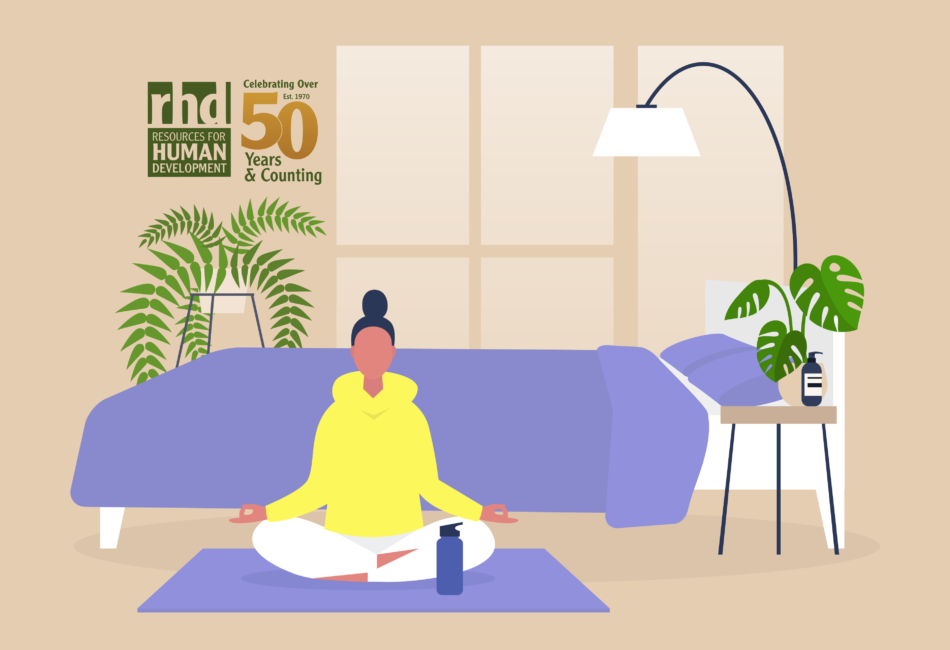COVID-19: Practicing Wellness and Managing Anxiety

April 13, 2021
RHD is committed to creating an environment that promotes the ongoing development and overall well-being of the individuals in our community, in alignment with our corporate values.
The COVID-19 pandemic has had a major effect on our lives. While COVID-19 vaccines have been rolled out, it’s important to stick to all other measures to stop transmission. RHD CEO Marco Giordano, in his communications to staff sites, always practicing the 4 w’s: wait and don’t go out if you have symptoms or have had close contact with someone with COVID-19, wash hands, wear masks and watch your distance from others. Also, follow the advice from the CDC and our local health authorities.
As the pandemic continues, it is becoming increasingly difficult to stay positive and strong. Many of us are exhausted by the combination of challenges people are facing and the necessary precautions we have to take and becoming increasingly wearied with quarantining, wearing masks, physical distancing, and being away from family and friends. Many are experiencing a type of burnout that experts are calling COVID-19 fatigue.
Public health directives are necessary to reduce the spread of COVID-19, but they can make us feel isolated and lonely and can increase stress and anxiety. Learning to cope with stress in a healthy way will make you, the people you care about, and those around you become more resilient.
Below are 10 steps, many of which are from RHD’s Department of Clinical Innovation and Quality (DCIQ), to help fight pandemic fatigue and manage anxiety.
10 Steps to Help Manage Anxiety during COVID-19
Step One – Validation
Validating and communicating feelings of worry, anxiousness, or loneliness because of social distancing or frustration with wearing masks is legitimate — and something many people experience. Take time to reflect on how you are doing. If you feel irritated, impatient, angry, or are suffering from fatigue, anxiety, or depression, accept that all of these responses are normal. It’s also important to seek out mental health care if you find yourself having thoughts of self-harm, hurting others, or engaging in reckless behavior.
Step Two – Refresh Coping Strategies
Since the pandemic began, COVID fatigue has set in for many. It can mean that our early coping strategies have fallen by the wayside.
Assess what’s still working and identify the strategies that have dropped off. Adding something novel can help remotivate you to focus on your emotional wellness. One idea is to try using a Seasonal Affective (or SAD) light designed to mimic the colors of daylight. Advantages include regulating sleep, improving focus, boosting energy, and helping combat the winter blues. SAD lights are affordable and could make a difference if you are not able to get enough outside time.
Step Three – Just Move and Use Your Senses!
Using your senses and moving your body are two of the most effective ways of improving mood, managing anxiety, and reducing depression. From your brain to your joints, moving every day has the power to improve every part of your body. Movement is not just about high-impact, sweat-inducing exercise either. Short little bursts during the day – as little as two minutes at a time – are all it takes.
Try rocking, bouncing on an exercise ball, balancing on one foot for a minute, taking a short “walk and talk” each day, doing 5-minute yoga stretches a couple of times a day, or have a five-minute dance party! Find ways to move and make it fun.
Of our five senses, smell is most closely linked with emotion and memory. Aromatherapy, which is the practice of using essential oils for therapeutic benefit, has been used for centuries to promote healing and well-being. Try lavender oil, often used to help relieve stress and promote relaxation, as a body oil or in a room diffuser.
Using our four other senses can ground us, take us out of our heads, and bring us back to our center. Here are some ideas:
- Taste: Is there something in your environment you can safely taste? If not, simply notice the taste inside your mouth at that moment.
- Touch: Find three ways to interact with your environment using your sense of touch. Can you run your fingers through the grass? Feel your back against your chair? Notice the cool air on your cheeks?
- Hearing: Close your eyes. Try to identify four different sounds you can hear and describe them to yourself in detail.
- Sight: Look around and find five different things in your environment that you can see. Describe them to yourself in as much detail as you can, as if you were trying to explain them to a blind person. Notice colors, shapes, light, shadow, etc.
Step Four – Talk Back Strategies
Talk back strategies help us with the way we think about things in our lives. Our thoughts create feelings, and our feelings often drive our actions.
This approach helps when we are feeling worried, anxious, or depressed – or when we’re stuck on a past challenge as well as worried about an uncertain future. If we’re never really in the present moment, we’ll become even more anxious, tossing between our worries.
Learning to talk back to worry thoughts, adopting a “big picture” perspective, and identifying two things to be grateful for each day are effective ways to help manage anxiety.
Step Five – Mindfulness
This step advocates taking hold of our thoughts and gaining control of negative emotions through practicing mindfulness. Mindfulness means becoming more aware of where you are and what you’re doing without becoming overly reactive or overwhelmed. Mindfulness practices have been shown to reduce the levels of stress and anxiety, provide increased focus and self-regulation, improve performance, promote good sleep, and create a greater sense of well-being.
You can practice mindfulness with simple acts and observations; it’s totally portable and needs no special space or tools. The real work is to make time every day to practice. Here’s a short exercise to get you started:
- Take a seat. Find a place to sit that feels calm and quiet to you.
- Set a time limit. If you’re just beginning, it can help to choose a short time, such as 5 or 10 minutes.
- Notice your body. You can sit in a chair with your feet on the floor, sit loosely cross-legged, assume a lotus posture, or kneel. Just make sure you are stable and in a position, you can maintain for a while.
- Feel your breath. Follow the sensation of your breath as it goes in and out.
- Notice when your mind has wandered. Inevitably, your attention will leave the sensations of the breath and wander to other places. When you become aware of this, simply return your attention to the breath.
- Be kind to your wandering mind. Don’t judge yourself or obsess over the content of the thoughts you find yourself lost in. Just come back.
Step Six – Maintain a Healthy Diet
Stress can drive many of us to unhealthy eating habits, but now is a critical time to eat well for the energy and stamina needed to deal with all the shifts and changes. Eating meals rich in plant-based foods, especially leafy vegetables and fruit, is beneficial to your health. Increase your consumption of diverse produce to gain more phytonutrients.
Taking steps to cut out inflammatory foods, such as sugar and bad fats, is also a good idea. These foods might be more tempting when you’re feeling tense or worried. Cook homemade foods with ginger and turmeric, or add a little rosemary to your meals to help you focus. Drink plenty of water, and consider trying green or black tea.
Step Seven – Breathe and Meditate
Breathing exercises are the simplest way to reduce stress and anxiety. Slow your breathing to tell your body that there’s no immediate threat. We’re built to kick into gear quickly if we need our “fight or flight” response, but stress also can trigger the same systems. It’s not good for our bodies to constantly be on high alert.
Before the day’s demands take over, become centered with some stress-relieving breaths. A technique called 4-7-8 breathing, or relaxing breath, is used to help with deep breath concentration. The practice is simple: breath in for a count of 4, hold for a count of 7, and breathe out for a count of 8. Practicing this for 4 breaths, 4 times each day or more, can help relieve anxiety and reset the autonomic nervous system.
Step Eight – Restore and Replenish
During difficult times, we need to carve outbreaks to restore and replenish our reserves. In order to take care of ourselves, we need to make deliberate decisions.
Take a walk. Take a bath. Read a book. Do things that are calming. Bring in something from the outdoors during long periods of inside time. Rocks, branches, flowers, or even a picture or screen saver depicting a beautiful scene can help remind you of nature. Listening to music that inspires you can help you focus and improve your mood.
Step Nine – Establish Community
It is important to find ways to stay connected electronically. Whether it’s playing computer games together, connecting through virtual calls, or scheduling regular telephone check-ins with family and friends, finding a way to establish community with someone creates a sense of normalcy.
Step Ten – Monitor Your Media Exposure
Purposely tuning in to negative stories on TV or on social media can fuel increased dread, uncertainty, anxiety, and fatigue. To combat this, try scheduling five-minute “check-in” sessions twice a day at most. If you’re hooked on checking your social feeds on your phone, remove the apps.
If you’re purposely watching cable news shows that are stressing you out, read a book, listen to music, or watch shows or movies that transport you to calmer times and places instead. Pick one or two trusted sources and screen out all the others.
Resources
The following resources provide additional strategies and tools to help improve mental and physical well-being:
Internal Resources
- DCIQ Care Package – Activity lists, strategies, and ideas, along with tips to help support mask-wearing and coping techniques for social distancing.
- Wellness Offerings – Creative ideas incorporating exercise, meditation, nutrition, and more.
- Open Door Hours – Supports connection and sharing ideas with others.
- DCIQ Team – Keep checking back for additional information on support programs with integrative approaches, including music, movement, sensory programs, and more.
- Reach Out – Reach out to a DCIQ member for consultation, support, and suggestions to help you and/or the people you serve.
External Resources
- Technology – Utilize apps like Bloom, Breath, Headspace, Provider Resilience, and more that are free or low-cost.
- UC Davis Health: https://health.ucdavis.edu/coronavirus/covid-19-information/covid-fatigue
- Phoenix VA Health Care System: https://www.phoenix.va.gov/features/Basics_of_quick_stress_relief.asp


